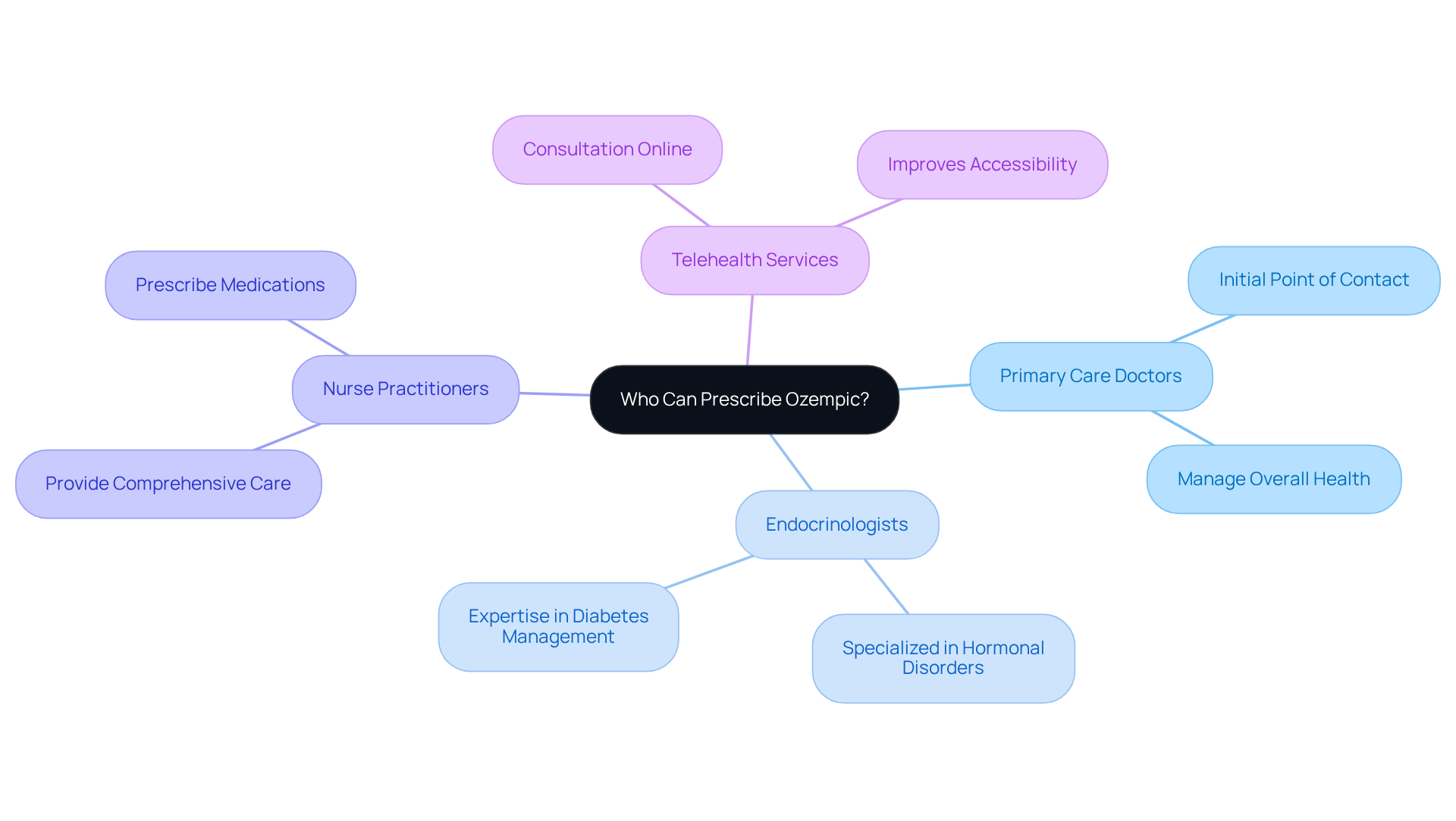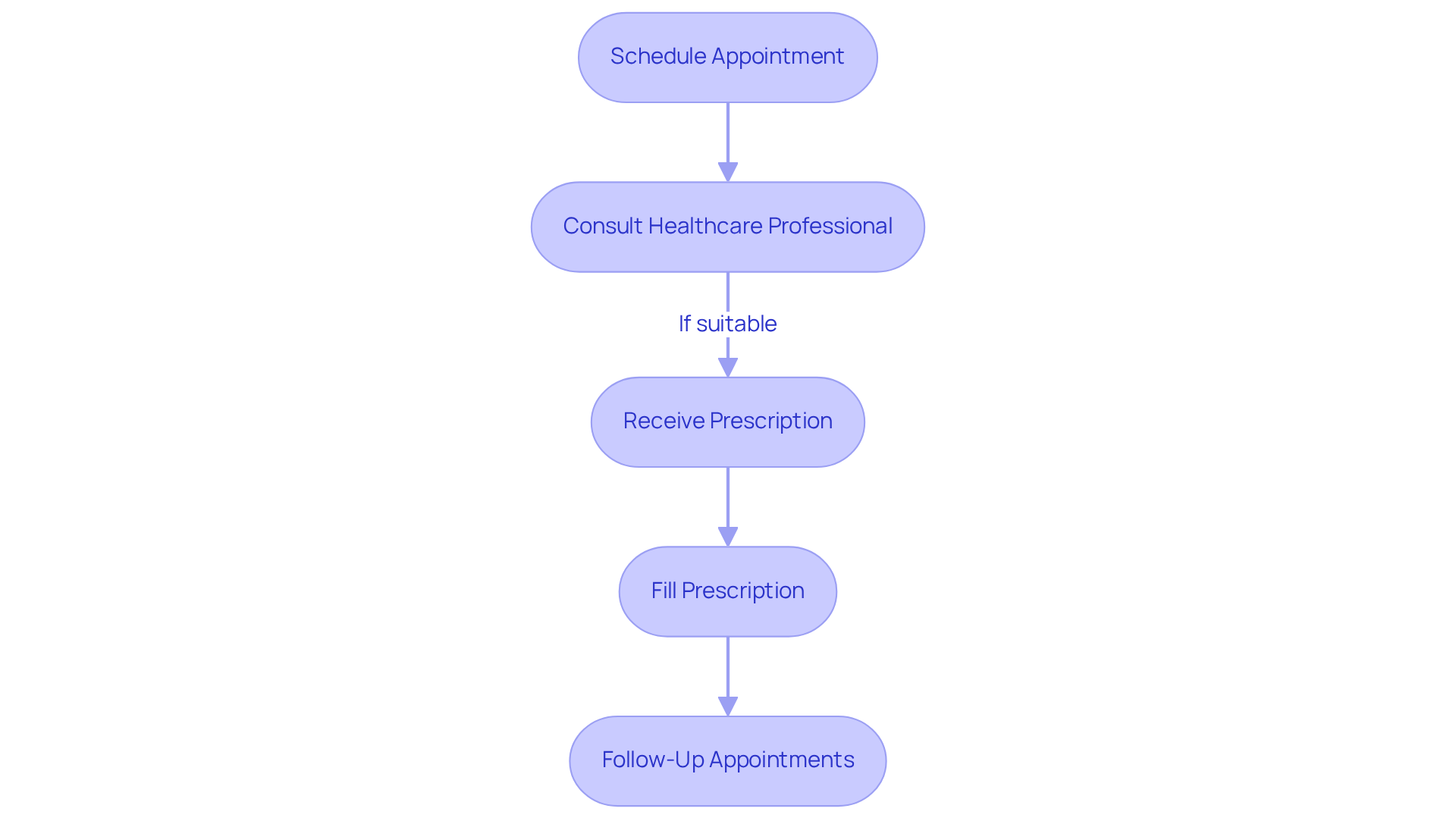Introduction
We understand that navigating the complexities of weight loss can feel overwhelming, especially when considering medical options like Ozempic. This medication, primarily recognized for its effectiveness in managing type 2 diabetes, has become a hopeful choice for those looking to lose weight by reducing appetite and increasing feelings of fullness.
However, the path to obtaining an Ozempic prescription isn’t always straightforward. It involves understanding the various healthcare providers and the eligibility criteria that come into play. Who can prescribe this medication? What steps do you need to take to access it?
You’re not alone in facing these questions. Many individuals share similar concerns, and it’s important to explore not just the potential benefits of Ozempic but also the intricacies of the prescription process. With the right guidance and support, you can navigate this journey with confidence.
Understanding Ozempic: Definition and Mechanism of Action
We understand that managing type 2 diabetes can be a challenging journey. Semaglutide, a GLP-1 receptor agonist, is here to help. This medication mimics the glucagon-like peptide-1 hormone, which plays a crucial role in regulating appetite and insulin secretion.
When you take semaglutide, it enhances insulin release in response to meals, decreases glucose production in the liver, and slows down gastric emptying. This combination can lead to increased feelings of fullness, effectively reducing overall food intake.
Moreover, while it aids in controlling blood sugar levels, semaglutide also promotes weight loss by fostering that sense of satiety. You’re not alone in this journey; many individuals find that managing their weight becomes more achievable with this support.
If you’re looking for a way to take control of your health, semaglutide might be the compassionate ally you need. Remember, every step you take towards better health is a step worth celebrating.

Who Can Prescribe Ozempic? Eligible Healthcare Providers
A variety of licensed medical professionals, including primary care doctors, endocrinologists, and nurse practitioners, who will prescribe Ozempic, can provide this medication. We understand that navigating healthcare can be challenging, but these professionals, who will prescribe Ozempic, are here to assess your health status and determine if it is the right treatment option for you.
In addition, the rise of telehealth services has transformed the prescription process. Now, you can consult with licensed professionals online, making it easier than ever to access the care you need. This innovation greatly improves accessibility, allowing individuals to obtain prescriptions for management solutions without the need for in-person visits.
Moreover, recent data shows that about 1 in 8 adults in the U.S. have tried a GLP-1 medication like Ozempic. This reflects its growing acceptance among healthcare providers, which is encouraging news for those seeking effective treatment options. You’re not alone in this journey; many are finding support through these advancements.
As telehealth continues to evolve, it plays a vital role in connecting patients with the medical knowledge they need to enhance their health improvement journeys. Remember, help is just a click away.

Eligibility Criteria for Ozempic Prescription: Are You a Good Candidate?
We understand that navigating the path to a prescription can feel overwhelming. To qualify, individuals typically need to meet specific criteria. Candidates usually should have a body mass index (BMI) of 30 or higher, or a BMI of 27 or higher if they face weight-related health conditions like type 2 diabetes, hypertension, or dyslipidemia.
Did you know that over 137 million adults in the U.S. are eligible for semaglutide based on these criteria? This highlights the significant number of individuals who could truly benefit from this treatment.
It’s crucial for prospective candidates to engage in a comprehensive conversation with their healthcare provider, who will prescribe ozempic, regarding their medical history and weight loss objectives. This personalized evaluation not only assesses whether the medication is appropriate but also determines who will prescribe ozempic to ensure that the treatment aligns with their overall health goals.
Moreover, real-life examples show that many patients successfully qualify for semaglutide treatment by meeting these BMI requirements and addressing relevant health conditions. This reinforces the importance of a customized approach to management. Remember, you’re not alone in this journey; support is available, and taking that first step can lead to positive change.

How to Obtain an Ozempic Prescription: Steps to Follow
If you’re considering a prescription for medication at CT Medical Weight Loss & Beyond, we understand that taking this step can feel overwhelming. Here’s how to navigate the process with care and support:
-
First, schedule an appointment with a licensed healthcare professional, either in-person or via telehealth. During this consultation, which typically lasts 30-45 minutes, you’ll have the opportunity to discuss your weight loss goals, medical history, and any current medications. Blood work may be requested and reviewed to ensure the best treatment plan tailored just for you.
-
If deemed suitable, the practitioner who will prescribe ozempic will issue a prescription. After receiving your prescription, you can fill it at a pharmacy or through an online pharmacy service. It’s essential to follow the prescribed dosage and schedule regular follow-ups with your healthcare provider to monitor your progress and adjust treatment as necessary.
At CT Medical Weight Loss & Beyond, we believe in a comprehensive approach to your weight loss journey. That’s why the initial consultation also includes a review of proper nutrition and best practices for effective medication use. You’re not alone in this journey; we’re here to support you every step of the way.
It’s worth noting that approximately 1 in 8 adults in the U.S. use a GLP-1 medication, highlighting its growing importance in managing body mass. As Dave Moore, Executive Vice President of U.S. Operations at Novo Nordisk, stated, “We are committed to ensuring that real, FDA-approved Wegovy and Ozempic are affordable and accessible to those who need them.”
However, it’s also important to be aware of potential side effects; for instance, nearly 37% of users experience nausea. Understanding these aspects can empower you to make informed decisions about your weight loss journey. Remember, we’re here to help you navigate this process with compassion and care.

Conclusion
Understanding your options for obtaining an Ozempic prescription is crucial if you’re looking for effective weight loss solutions. This medication mimics natural hormones to help regulate appetite and insulin, offering a promising pathway for those managing type 2 diabetes and weight-related health issues. By recognizing which healthcare providers can prescribe Ozempic and the eligibility criteria involved, you can take informed steps toward enhancing your health.
Throughout this discussion, we’ve highlighted key points, including the roles of various healthcare professionals – from primary care doctors to nurse practitioners – in prescribing Ozempic. The rise of telehealth services has made it even easier to access these prescriptions, allowing you to consult licensed professionals from the comfort of your home. Moreover, understanding the eligibility requirements, such as BMI thresholds, empowers many potential candidates to explore this treatment option.
Ultimately, your journey toward weight loss and better health is a collaborative effort that begins with a conversation with a healthcare provider. Engaging in this dialogue not only clarifies the prescription process but also reinforces the importance of personalized care. You’re not alone in this journey; as more individuals discover the benefits of Ozempic, the message remains clear: support and resources are available. Taking that first step can lead to meaningful changes in your health and well-being.
Frequently Asked Questions
What is Ozempic?
Ozempic is a medication that contains semaglutide, a GLP-1 receptor agonist used to help manage type 2 diabetes.
How does semaglutide work?
Semaglutide mimics the glucagon-like peptide-1 hormone, enhancing insulin release in response to meals, decreasing glucose production in the liver, and slowing gastric emptying.
What are the effects of taking semaglutide?
Taking semaglutide can lead to increased feelings of fullness, reduced overall food intake, and improved blood sugar control. It also promotes weight loss by fostering a sense of satiety.
Can semaglutide help with weight management?
Yes, many individuals find that semaglutide helps make managing their weight more achievable by promoting feelings of fullness.
Who can benefit from using semaglutide?
Semaglutide is beneficial for individuals managing type 2 diabetes and those looking to control their weight as part of their health journey.



